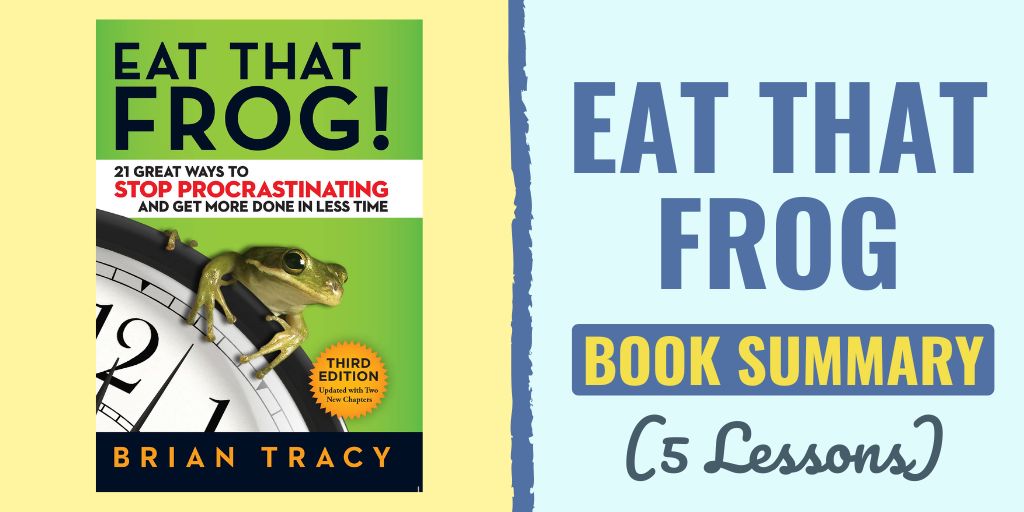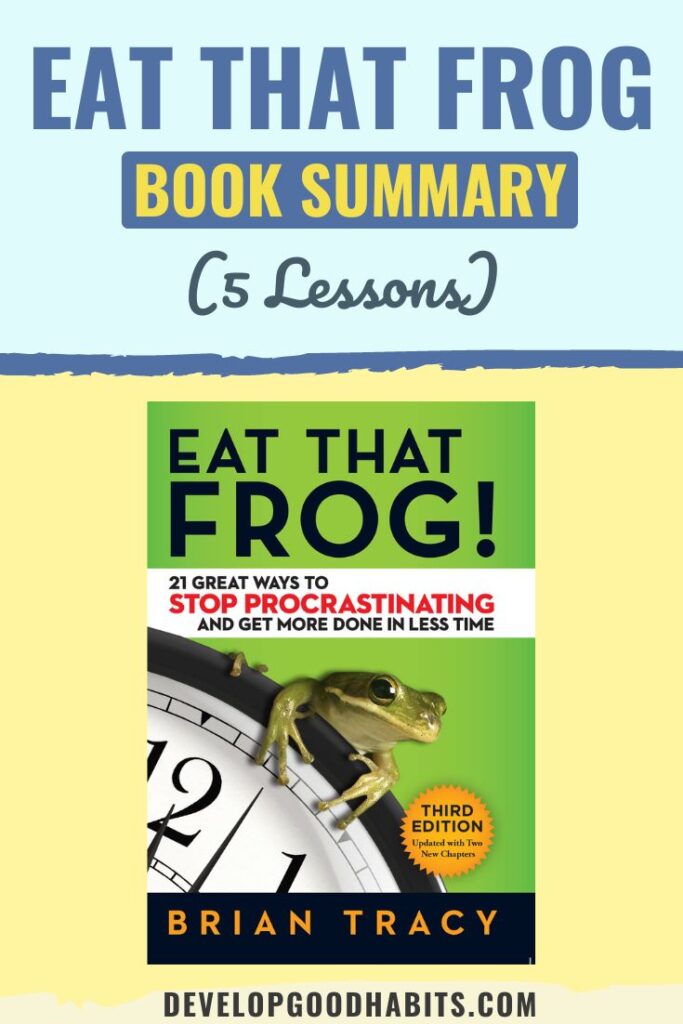There might be affiliate links on this page, which means we get a small commission of anything you buy. As an Amazon Associate we earn from qualifying purchases. Please do your own research before making any online purchase.
Do you struggle with procrastination?
Or are you having trouble getting enough done in the day to stay on track and accomplish your goals?
If so, then you might be interested in checking out Brian Tracy’s book, Eat That Frog, which offers research-backed and practical advice to help you become a productivity dynamo.
These techniques are time-tested and can help you focus on what is most important, as well as help you accomplish what you need to do in less time.
In this article, we’ll provide a brief overview of Eat That Frog, and then we will talk about five lessons you can learn from this classic book.
Or, if you prefer to watch instead of read, here's the video version of this article:
An Overview of Eat That Frog
First off… Why did Brain Tracy call his book Eat That Frog?
The metaphor of “eating a frog” stresses the importance of prioritizing your work.
Your “frog” represents the most important task you need to accomplish, and by “eating” it first thing in the morning, you'll set yourself up for success throughout the day.
The basic concepts that Tracy promotes in his book include:
Taken together, these are all the things you need to know to become a productivity master.
Now you know all of the basics, let’s take a plunge into the pond and really understand what these frogs are about with five lessons from Brian Tracy’s “Eat That Frog.”
Check Price on Amazon | Check Audiobook Price
Lesson #1: Prioritize!
Brain Tracy states that prioritization is a skill that everyone needs to master. He gives us three practical ways of developing this skill.
Starting with…
The ABCDE Method
This is a simple and intuitive way of organizing all the tasks in your daily routine.
Here’s how to follow this method:
This method makes it easier to understand what your most important objectives are for the day.
It also ensures that you don’t get distracted by busy work.
Now, let’s look at the second prioritization principle.
The Pareto Principle
The Pareto Principle is usually known as the 80/20 rule.
This rule suggests that 80 percent of your results only come from 20 percent of your actions.
This rule has been applied to many different contexts;
Many companies find that 80 percent of their revenue comes from a much smaller section of their customers than they realized.
The Pareto Principle even applies to war, with usually only 20 percent of the soldiers in a front-line engagement doing 80 percent of the fighting.
Nobody knows why this is, but the Pareto Principle has been observed across countless different disciplines.
To apply this to your life, you have to find out what your 20 percent is and give that more attention. This allows you to put your energy where it really counts and achieve more with less.
For more on this concept, check out our video about the 80/20 rule:
The Law of Three
The Law of Three is a technique that helps you identify the three most important tasks you need to complete daily.
Here’s how to apply this method:
With this method, you learn to concentrate on what truly matters, improving your productivity and effectiveness.
If you want to master the skill of prioritization, the ABCDE method, The 80/20 Rule, and The Law of Three are all you need.
Lesson #2: Plan to Succeed!
Having a goal is one of the most important pieces of the productivity puzzle.
A goal is like a compass, if you don’t have one then you might just end up going in circles.
Planning and goal setting is essential, and having a few tools to make this process easier can work wonders.
Here are some Planning and Goal Setting methods Brian Tracy recommends:
Write Down Your Goals
Think about what you want to accomplish, both professionally and personally.
Writing down goals is a way of making a commitment, it helps with focus and it serves as direction on days when you might be feeling less motivated.
Create an Action Plan
Now you have your goals, what do you do with them?
Over time, this serves as a roadmap that you can follow without having to spend time each day thinking about how you’re going to achieve an objective.
For more on this, watch our video about the SMART goals process with 21 examples:
Long Term VS Short Term Goals
Both long-term and short-term goals are crucial for success.
Long-term goals provide you with a sense of direction and purpose, while short-term goals help you make steady progress.
To maintain a balance between the two, organize your goals into Long Term and Short Term:
Break your long-term goals into actionable steps and set short-term goals to reach them.
This allows you to measure your progress and stay motivated as you work towards your ultimate objectives.
Remember to track and evaluate your progress regularly.
Adjust your plans as needed to ensure that you stay on course and continue moving towards your goals
Remember, no matter how good your plan is, it will never account for all the possibilities life can throw at you. But at the same time, planning is one of the most valuable things you can do when it comes to success.
Lesson #3: Stay Focused!
Focus is the great force multiplier, practically everyone who knows anything about success and productivity will tell you that without good focus you can’t achieve much.
Brain Tracy shares two powerful focusing tools with us in his book:
Method Number 1: The Swiss Cheese Method
The Swiss Cheese Method encourages you to break your tasks into smaller, more manageable pieces.
By doing this, you can start working on parts of a task rather than feeling overwhelmed by the entire project.
When you chip away at a project like this, you'll slowly “create holes” in it, much like Swiss cheese.
Breaking a task into smaller and more manageable chunks makes even monumental projects feel achievable.
Here’s how to do The Swiss Cheese Method in four steps:
Step 1: Identify the most significant project you have.
Step 2: Break it down into smaller tasks or steps.
Step 3: Choose one small task and complete it.
Step 4: Continue with this process, tackling one task at a time.
Method Number 2: The Salami Slicing Technique
Feeling hungry yet?
This approach is similar to the Swiss Cheese Method in that it involves breaking down tasks into smaller segments, but with a slightly different mindset.

Instead of focusing on creating “holes” in a project, you “slice” it into thin, manageable strips, just like slices of salami.
Here’s how to do the Salami Slicing Technique in four steps:
Step 1: Write down your big goal or project.
Step 2: Divide it into smaller segments or milestones.
Step 3: Work on one segment at a time, just as you would eat a slice of salami.
Step 4: Keep working on each slice until the entire “salami” is consumed.
Remember, when trying out these techniques, the key is consistency and patience. Dividing big tasks into manageable chunks is the key to turning feelings of overwhelm into feelings of motivation.
Lesson #4: Don’t Let Procrastination Take Over
Procrastination is something that everyone struggles with.
Putting off important tasks has been a problem for humans as long as there has been recorded history.
Brian Tracy provides us with some helpful methods to help us beat the procrastination scourge:
Method 1: The 4D Method
The 4D Method is a simple yet effective way to tackle your tasks and overcome procrastination.
Here's how you can apply it:
The first D stands for Do it now: If a task will take a short amount of time to complete and is a priority, don't hesitate, just do it immediately.
The second D stands for Delegate: If someone else can complete the task more efficiently or effectively, assign it to them.
The third D stands for Defer:If a task isn't urgent or important, schedule it for a later time.
The fourth D stands for Delete: If a task is neither important nor urgent, it may be best to eliminate it from your to-do list entirely.
By using the 4D Method, you can better prioritize your tasks and make sure you're focusing on the most important ones first.
Method 2: Set Deadlines
Establishing deadlines for your tasks is another effective strategy to overcome procrastination.
Here are some tips on how to set realistic deadlines:
Regularly track your progress and adjust the deadlines as necessary if you see you're falling behind or making faster-than-expected progress.
Lesson #5: Make Your Workflow Work For You
Simply having a load of work in the pipeline is a surefire way to make yourself overwhelmed and stressed out.
Having an unorganized jumble of tasks to complete can make you waste time and energy running in circles, whereas an organized workflow can make your day flow smoothly and easily.
Brian Tracy recommends two easy methods in Eat That Frog:
Method 1: Batching Tasks
To use this method, group similar tasks together and complete them in a dedicated time block.
Here's a simple way to batch tasks:
For example, if you have several emails to respond to and a few phone calls to make, dedicate a specific time slot for handling communication-related tasks.

By using this method, you reduce the time and mental effort needed to switch between different types of tasks.
Method 2: Eliminate Unnecessary Tasks
According to Eat That Frog, it's crucial to prioritize your tasks and focus on the most significant and impactful ones (your “frogs”).
One way of doing this is by eliminating all the tasks which don’t contribute that much to your day. Instead, you focus only on the most impactful ones.
Here are some tips to do this:
By batching tasks and eliminating unnecessary ones, you'll be well on your way to a more efficient and optimized workflow.
Eat That Frog is chock full of lessons you can learn to master productivity and achieve your goals without burning yourself at both ends of the candle.
Now, as a reminder, if you’d like to check out the book, we’ve included a link to it in the description box of this video.
And if you want to learn more about this topic, then be sure to check out our video about the 5 habits you can use to overcome procrastination:
Final Thoughts on Brian Tracy’s Eat That Frog!
“Eat That Frog!” is a practical guide to overcoming procrastination and increasing productivity. It provides readers with valuable strategies and techniques for tackling their most important tasks head-on, rather than succumbing to the allure of easy or less important activities.
By highlighting the importance of prioritization, setting clear goals, and taking decisive action, Tracy empowers readers to take control of their time and accomplish more in their personal and professional lives.
The emphasis on developing good habits and cultivating a positive mindset serves as a powerful reminder that success is a result of consistent effort and discipline, as well as taking responsibility for one's actions and embracing discomfort to achieve long-term goals.
Ultimately, this book serves as a valuable resource for anyone seeking to create a path towards success in all areas of life.
And if you’re looking for more great books to improve your life, check out our recommendations:




